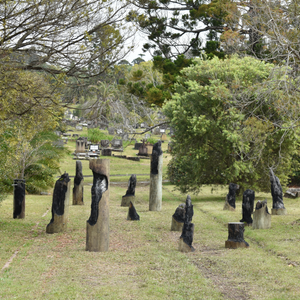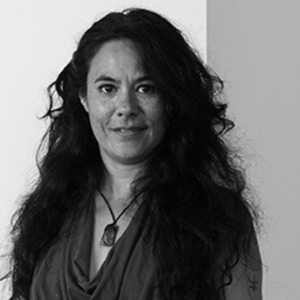STILL (once trees) (2020)
Burnt telegraph poles

Burnt, truncated telegraph poles are barely standing at the edge of the road; the black summer fires have made their own memorial. I rescued them from Lake Conjola area on Dharawal Yuin country. The 20 ravaged poles now located at Rookwood Cemetery on Dharug land – it becomes another memorial – asking us to be present with it on an intimate level, with the stillness of death and silence of Country after the unprecedented catastrophe.
Whilst the pandemic may have blunted the memory of the devastation, it is necessary to remember the land, people and animals are still deeply affected. And that the fires will come again.
About the Artist
 Stevie Fieldsend is of Samoan and European heritage, she was born in Aotearoa (New Zealand) and currently lives on Wangal Country in Sydney’s Inner West. She studied glass at The Jam Factory Craft and Design Centre in Adelaide and has a Master of Fine Art from Sydney College of the Arts. Stevie’s work has been presented at Sydney Contemporary, Melbourne Art Fair, Art Central Hong Kong, Moreton Bay Regional Gallery, Caboolture Regional Art Gallery, Cessnock Regional Art Gallery, and Blacktown Arts Centre; and collected by Artbank, Macquarie Group Collection and Bridging Hope Charity Foundation Collection. Stevie is represented by Artereal Gallery Sydney.
Stevie Fieldsend is of Samoan and European heritage, she was born in Aotearoa (New Zealand) and currently lives on Wangal Country in Sydney’s Inner West. She studied glass at The Jam Factory Craft and Design Centre in Adelaide and has a Master of Fine Art from Sydney College of the Arts. Stevie’s work has been presented at Sydney Contemporary, Melbourne Art Fair, Art Central Hong Kong, Moreton Bay Regional Gallery, Caboolture Regional Art Gallery, Cessnock Regional Art Gallery, and Blacktown Arts Centre; and collected by Artbank, Macquarie Group Collection and Bridging Hope Charity Foundation Collection. Stevie is represented by Artereal Gallery Sydney.
Transcription
Hi, my name is Stevie Fieldsend and my work is called STILL (once trees). So the installation consists of twenty burnt telegraph poles that I found down in the Lake Conjola, Bendalong along area close to my regular camp site. And I found them, you know, shortly after the black summer 2020 fires raged through.
The camp site itself had been saved by a change of wind, but everything around it, all all the bush right down to the water for as far as I could see, was completely decimated. It was absolutely devastating and it was sort of like it was like walking into a blackened still life. There was just nothing. There was no birds, no cicadas, no possums, there was just nothing. Anyhow, on our trips in and out town I kept seeing these telegraph poles all laying or barely standing beside the beside the road and and I thought to myself, you know, I mean some of them only forty centimes high.
And I thought to myself, wow, what a powerful analogy for a total breakdown and communications and the powers that be, in particular the government's response to to the fires, or should I say lack of response, and I thought no, I must, I have to come back and get these. So I went back to Sydney and returned about two weeks later in a budget truck. And, yes, I mean I guess this is the process bit, but there's not much of a process in making these, because the fires has made these telegraph poles. What you see is how I found them. I did nothing to them except rescue them and then seal them and put a hole in the base so they could be put over a spigot. But what you see is what I found.
So yes, anyway, and this is a bit of a funny story, and that I went to get them in the truck and arrived at dusk and I couldn't see them. I was like, Oh, no, I hope they're not gone, maybe I just can't see them. And sure enough, the next morning when I went up to have a look, they were all gone. And Anyway, we were traveling along and saw that there was a massive council truck on the side of the road. It was a Saturday morning and we went and had a look in the back of the truck and sure enough, they were all there. So we took twenty of them and left them four so they would have got to the the council guys would have got to the tip and on the Monday morning and just gone what the so it was a little bit funny. Yeah, and then I yes, then I brought them home and they've been in my backyard for the last two and a half years literally growing moss.
And and here they are for you guys. How do what do I want? How does it relate to Rookwood? Ah, well, if this isn't about death, I don't know what it is. We're talking, you know, three billion, over three billion animals killed, thirty three people and millions and millions and millions of hectares burnt. I mean the devastation, it's a devastation was just unprecedented. You know, it's an ecological disaster and and I guess you know, what I'm wanting the viewer to take away from this work is, you know, since we're in metropolitan Sydney, you can sort of forget that there are still all of these communities and all of those ecologies and all those animals.
You know, there's there's still so much people and land and animals affected by this. You know, it's not over for them and and it's not over for us. So I guess I'm just wanting this to create conversation and to create a sense of empathy and to remind people that you know the land and, as I said, people and animals are still deeply affected and that we need to have more, a whole lot more conversation and a holistic sense. You know, I think the First Nations land management experts need to be called to the table and that we need to listen to them about how we manage the land and in preparation for fires that will come again, because they will.